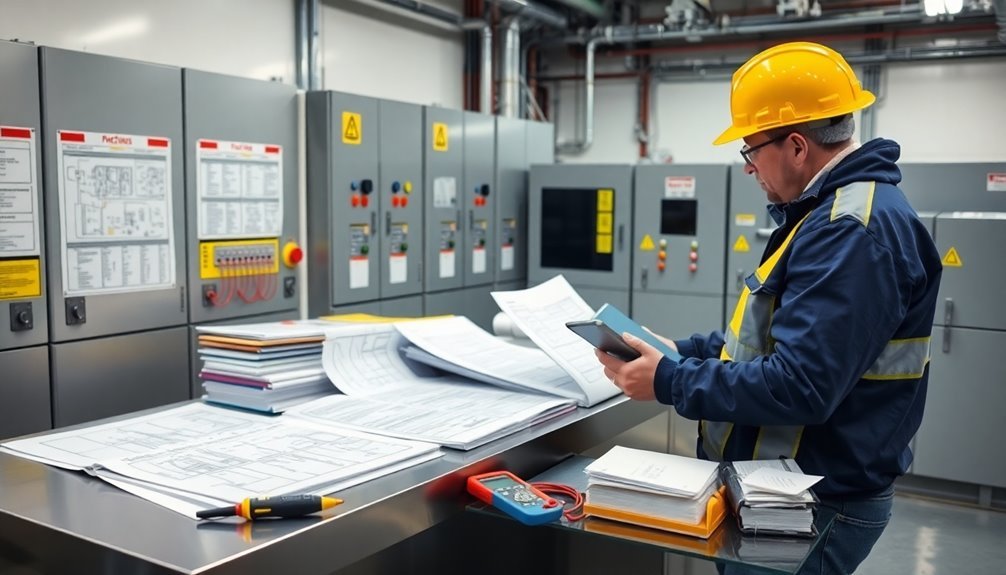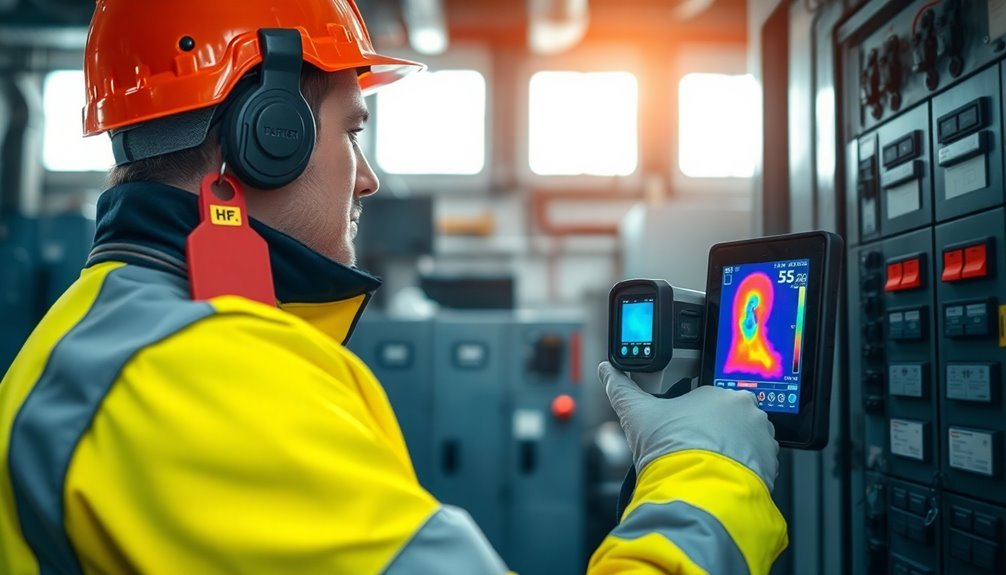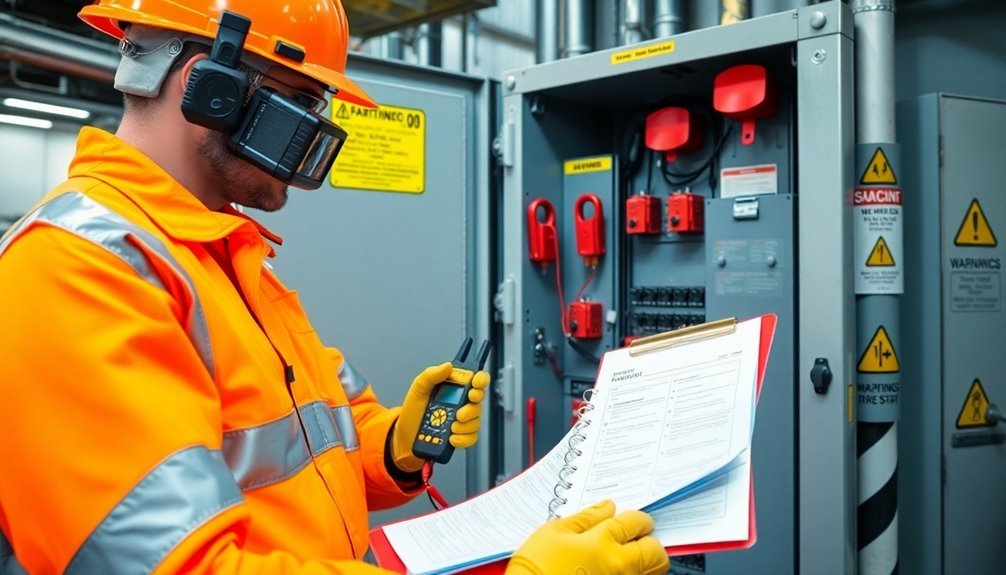To guarantee electrical safety compliance, you'll need to follow three essential steps. Start by preparing detailed audit documentation, including electrical drawings, equipment manuals, and safety protocols that match your facility's specific requirements. Next, conduct thorough equipment inspections to check for wear, damage, and proper installations while verifying that all components meet current safety standards. Finally, execute critical safety improvements by implementing protective measures, updating procedures, and training employees on new protocols. Following these steps will help you maintain a safer workplace and discover additional ways to enhance your facility's electrical safety program.
Prepare Comprehensive Audit Documentation

Setting up thorough audit documentation marks the critical first step in conducting an effective electrical safety audit. You'll need to gather essential documents, including single-line diagrams (SLDs), electrical drawings, equipment manuals, and maintenance records. These materials provide the foundation for understanding your facility's electrical system layout and identifying potential issues.
Start by reviewing your maintenance history and safety training records to verify employee compliance and competency. Incorporating lockout/tagout procedures into your documentation ensures safe maintenance practices.
You'll want to customize your audit checklist to match your facility's specific requirements, considering factors like equipment types and building size. Make certain you've included all relevant safety regulations and standards that apply to your electrical systems.
When organizing your documentation, implement a systematic approach to review all electrical components. Document your findings with detailed descriptions and photographs of any hazards or compliance issues you discover.
Don't forget to update your maintenance records and develop clear corrective action plans for addressing identified problems.
Your final documentation should include a detailed report that details all findings, recommendations, and required corrective actions, prioritized by risk severity. This structured approach maintains a continuous improvement cycle in electrical safety management.
Inspect Electrical Equipment Conditions
A thorough inspection of electrical equipment forms the cornerstone of any safety audit. You'll need to conduct detailed visual examinations, checking for wear, damage, and improper installations.
Make sure you're verifying that all equipment is properly grounded and that wires don't show signs of fraying or exposed conductors. Regular inspections by licensed electrical professionals help ensure compliance with safety standards and prevent potential hazards.
When evaluating compliance, you must confirm that your electrical equipment meets all required standards and codes. Don't forget to verify that equipment ratings match their protective circuits and that main switches are easily accessible. Check that your fuse boxes are secure and that only authorized personnel have access to them.
Pay special attention to environmental factors during your inspection. You'll want to identify any wires in damp areas or standing water, safeguarding all equipment against moisture. Look for wires that might obstruct walkways or create tripping hazards, and verify that outdoor equipment is housed in weatherproof enclosures.
Remember to evaluate your safety procedures as you inspect. Confirm that your employees are properly trained and equipped with appropriate PPE. Maintain clear reporting guidelines for electrical hazards and keep your safety documentation up-to-date.
Execute Critical Safety Improvements

The successful execution of critical safety improvements demands a systematic approach to risk mitigation. You'll need to prioritize the most significant hazards identified during your assessment and implement protective measures accordingly.
Start by evaluating your electrical system risks through fault current calculations and arc flash analysis to determine which areas require immediate attention. Using specialized testing equipment and diagnostic tools ensures accurate hazard measurement data during your evaluation process.
Once you've identified high-risk areas, implement essential protective measures. Install GFCIs where required, verify grounding equipment capabilities, and establish proper lockout/tagout procedures.
You'll also need to enhance your electrical safety procedures by updating protocols and confirming they comply with current regulations. Don't forget to train your employees on these new procedures and hazard recognition techniques.
Monitor your safety improvements through regular follow-up audits. You should track the effectiveness of implemented changes and make necessary adjustments to your safety procedures.
Create a timeline for ongoing assessments and establish clear metrics for success. Remember to foster a safety-first culture by recognizing and rewarding safe behavior among your employees.
This continuous improvement approach confirms your electrical safety measures remain effective and compliant with industry standards.
Frequently Asked Questions
How Often Should Electrical Safety Audits Be Conducted for Optimal Compliance?
You'll need to conduct electrical safety audits every 1-3 years for general industries, every 3 years for industrial facilities, and every 5 years for commercial properties, with additional audits after system changes or incidents.
What Qualifications Should Electrical Safety Auditors Possess?
You'll need proper certifications like CSA-ES or CESCP, 40-45 hours of electrical safety training, current CPR/AED certification, and experience as a Qualified Electrical Worker with documented audit experience within the past three years.
Can Employees Participate in Safety Audits While Equipment Remains Operational?
Yes, you can participate in safety audits while equipment runs, but you'll need proper training and supervision. Only observe and report hazards without interfering unless there's an immediate safety risk requiring shutdown.
What Emergency Protocols Should Be in Place During Electrical Audits?
You'll need emergency response plans, PPE, communication protocols, and designated response teams in place. Make sure you've got clear evacuation routes, first aid equipment, and know when to contact emergency services.
How Do Weather Conditions Affect Outdoor Electrical Safety Audit Procedures?
You'll need to adjust your audit procedures during wet weather. Don't perform outdoor inspections in heavy rain, guarantee proper PPE, watch for slip hazards, and check equipment for water damage before testing.
In Summary
You'll stay ahead of safety requirements by following these three essential electrical audit steps. Keep your documentation thorough and up-to-date, regularly assess your equipment's condition, and promptly address any safety concerns you discover. Don't wait for problems to escalate – taking proactive measures now will protect your workers, maintain compliance, and prevent costly violations. Make electrical safety audits a consistent priority in your facility.





Leave a Reply